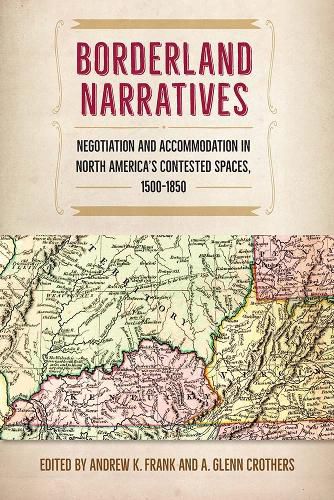Readings Newsletter
Become a Readings Member to make your shopping experience even easier.
Sign in or sign up for free!
You’re not far away from qualifying for FREE standard shipping within Australia
You’ve qualified for FREE standard shipping within Australia
The cart is loading…






This title is printed to order. This book may have been self-published. If so, we cannot guarantee the quality of the content. In the main most books will have gone through the editing process however some may not. We therefore suggest that you be aware of this before ordering this book. If in doubt check either the author or publisher’s details as we are unable to accept any returns unless they are faulty. Please contact us if you have any questions.
Broadening the idea of
borderlands
beyond its traditional geographic meaning, this volume features new ways of characterizing the political, cultural, religious, and racial fluidity of early America. It extends the concept to regions not typically seen as borderlands and demonstrates how the term has been used in recent years to describe unstable spaces where people, cultures, and viewpoints collide.
The essays include an exploration of the diplomacy and motives that led colonial and Native leaders in the Ohio Valley–including those from the Shawnee and Cherokee-to cooperate and form coalitions; a contextualized look at the relationship between African Americans and Seminole Indians on the Florida borderlands; and an assessment of the role that animal husbandry played in the economies of southeastern Indians. An essay on the experiences of those who disappeared in the early colonial southwest highlights the magnitude of destruction on these emergent borderlands and features a fresh perspective on Cabeza de Vaca. Yet another essay examines the experiences of French missionary priests in the trans-Appalachian West, adding a new layer of understanding to places ordinarily associated with the evangelical Protestant revivals of the Second Great Awakening.
Collectively these essays focus on marginalized peoples and reveal how their experiences and decisions lie at the center of the history of borderlands. They also look at the process of cultural mixing and the crossing of religious and racial boundaries. A timely assessment of the dynamic field of borderland studies, Borderland Narratives argues that the interpretive model of borders is essential to understanding the history of colonial North America.
Contributors: Andrew Frank; A. Glenn Crothers; Rob Harper; Tyler Boulware; Carla Gerona; Rebekah M. K. Mergenthal; Michael Pasquier; Philip Mulder; Julie Winch.
$9.00 standard shipping within Australia
FREE standard shipping within Australia for orders over $100.00
Express & International shipping calculated at checkout
Stock availability can be subject to change without notice. We recommend calling the shop or contacting our online team to check availability of low stock items. Please see our Shopping Online page for more details.
This title is printed to order. This book may have been self-published. If so, we cannot guarantee the quality of the content. In the main most books will have gone through the editing process however some may not. We therefore suggest that you be aware of this before ordering this book. If in doubt check either the author or publisher’s details as we are unable to accept any returns unless they are faulty. Please contact us if you have any questions.
Broadening the idea of
borderlands
beyond its traditional geographic meaning, this volume features new ways of characterizing the political, cultural, religious, and racial fluidity of early America. It extends the concept to regions not typically seen as borderlands and demonstrates how the term has been used in recent years to describe unstable spaces where people, cultures, and viewpoints collide.
The essays include an exploration of the diplomacy and motives that led colonial and Native leaders in the Ohio Valley–including those from the Shawnee and Cherokee-to cooperate and form coalitions; a contextualized look at the relationship between African Americans and Seminole Indians on the Florida borderlands; and an assessment of the role that animal husbandry played in the economies of southeastern Indians. An essay on the experiences of those who disappeared in the early colonial southwest highlights the magnitude of destruction on these emergent borderlands and features a fresh perspective on Cabeza de Vaca. Yet another essay examines the experiences of French missionary priests in the trans-Appalachian West, adding a new layer of understanding to places ordinarily associated with the evangelical Protestant revivals of the Second Great Awakening.
Collectively these essays focus on marginalized peoples and reveal how their experiences and decisions lie at the center of the history of borderlands. They also look at the process of cultural mixing and the crossing of religious and racial boundaries. A timely assessment of the dynamic field of borderland studies, Borderland Narratives argues that the interpretive model of borders is essential to understanding the history of colonial North America.
Contributors: Andrew Frank; A. Glenn Crothers; Rob Harper; Tyler Boulware; Carla Gerona; Rebekah M. K. Mergenthal; Michael Pasquier; Philip Mulder; Julie Winch.